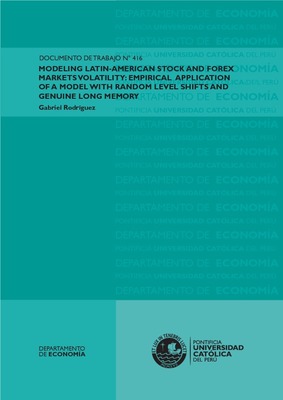| dc.description.abstract | Following Varneskov and Perron (2014), I apply the RLS-ARFIMA(0,d,0) and the RLS-ARFIMA (1,d,1) models to the daily stock and Forex market returns volatility of Argentina, Brazil, Chile, Mexico and Peru. It is a parametric state-space model with an estimation framework that combines long memory and level shifts by decomposing the underlying process into a simple mixture model and ARFIMA dynamics. The full sample parameters estimates show that level shifts are rare but they are present in all series. A genuine long-memory component is present in volatility of some countries and the results suggest that the remaining short-memory component is nearly uncorrelated once the level shifts are accounted for. I compare the results with four RLS models as in Xu and Perron (2014) and applied in Rodríguez (2016) for same Latin-American series. An out-of-sample forecasting comparison is also performed using the approach of Hansen et al. (2011). The RLS-ARFIMA models presents better performance for some horizons while the other four RLS models are better for other horizons. In none horizon of forecasting, simple ARFIMA models are selected or belong to the 10% of the MCS of Hansen et al. (2011).
Siguiendo Varneskov y Perron (2014), yo aplico los modelos RLS-ARFIMA (0,d,0) y RLS-ARFIMA (1,d,1) a datos diarios de las volatilidades de los mercados bursátiles en Argentina, Brasil, Chile, México y Perú. Este modelo es de tipo paramétrico en forma espacio estado y su estimación combina una mezcla de un proceso de larga memoria con cambios de nivel. Esto se hace descomponiendo el proceso subyacente en un modelo de mezcla simple con dinámica ARFIMA. Las estimaciones de parámetros muestran que los cambios de nivel son raros, pero ellos están presentes en todas las series analizadas. Un componente de genuina larga memoria es encontrado en la volatilidad de algunos países y los resultados sugieren que el componente de corta memoria remanente es prácticamente no correlacionado una vez que los cambios de nivel son tomados en cuenta. Los resultados son comparados con aquellos obtenidos en cuatro modelos propuestos en Xu y Perron (2014) y también usados en Rodríguez (2016) para las mismas series de América Latina. Una comparación de predicción fuera de muestra también es realizada usando el enfoque de Hansen et al. (2011). Los modelos RLS-ARFIMA presentan mejor performance para algunos horizontes, mientras que los otros cuatro modelos RLS son mejores para otros horizontes. En ningún horizonte de predicción se seleccionan los modelos ARFIMA, o en ningún caso pertenecen al 10% del MCS propuesto por Hansen et al. (2011). | en_US |


